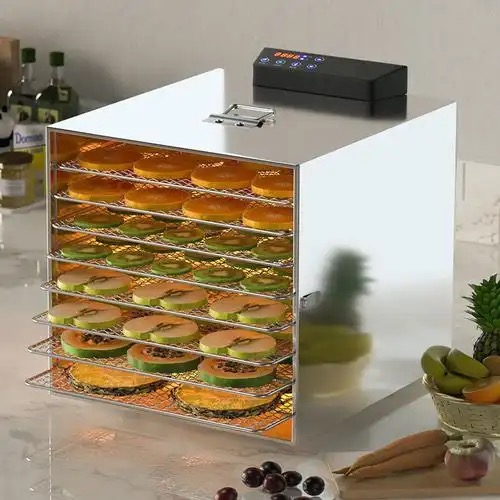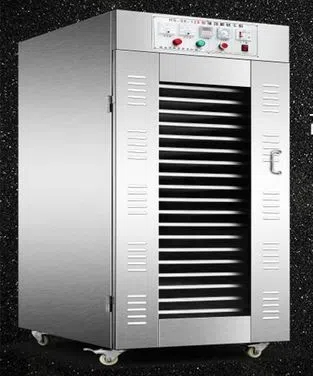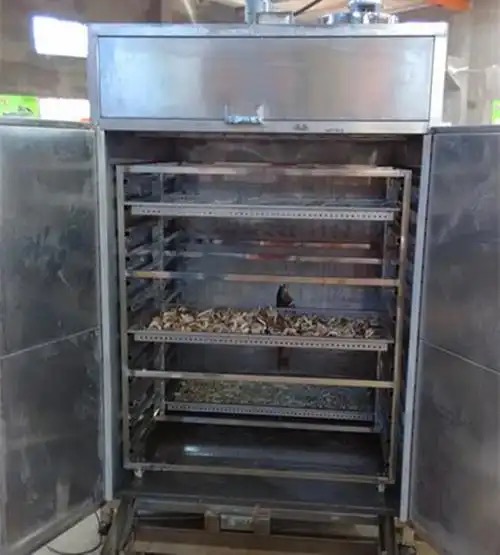
Content Menu
● Understanding Heat Pump Dryers
● How Heat Pump Dryers Work
● Comparative Efficiency: Heat Pump vs. Traditional Dryers
● Advantages of Using Heat Pump Dryers
● Applications of Heat Pump Dryers
● Performance Metrics: Measuring Efficiency
● Challenges and Considerations
● Future Trends in Food Drying Technology
● Conclusion
● FAQ
>> 1. What is a heat pump dryer machine?
>> 2. How does a heat pump dryer compare to a traditional dehydrator?
>> 3. Can I use a heat pump dryer for all types of food?
>> 4. What are the main benefits of using a heat pump dryer?
>> 5. How long does it take to dry food using a heat pump dryer?
In the realm of food preservation, drying is a critical process that extends the shelf life of various products, from fruits and vegetables to meats and herbs. Among the different drying technologies available, heat pump dryer machines stand out for their efficiency and effectiveness. This article delves into the workings of heat pump dryers, compares their efficiency with traditional drying methods, and explores their benefits in food processing.

Understanding Heat Pump Dryers
Heat pump dryers operate on a unique principle that sets them apart from conventional drying methods. They utilize the reverse Carnot cycle to transfer heat instead of generating it directly. This process involves absorbing heat from the surrounding air, compressing it, and then releasing it into the drying chamber. The result is a controlled environment that maintains optimal temperature and humidity levels for efficient drying.
Key Components of Heat Pump Dryers:
- Compressor: Increases the temperature of the refrigerant by compressing it.
- Condenser: Releases heat into the drying chamber while cooling the refrigerant.
- Evaporator: Absorbs heat from the outside air.
- Expansion Valve: Regulates the flow of refrigerant within the system.
How Heat Pump Dryers Work
The operation of a heat pump dryer can be summarized in several steps:
1. Air Intake: The machine draws in ambient air, which contains moisture.
2. Heat Absorption: The evaporator absorbs heat from this air, causing the refrigerant to vaporize.
3. Compression: The compressor compresses this vapor, raising its temperature significantly.
4. Heat Release: The hot refrigerant passes through the condenser, where it releases heat into the drying chamber, warming the air inside.
5. Moisture Removal: As the warm air circulates around the food, it absorbs moisture and carries it away through exhaust vents.
6. Cycle Continuation: The cooled refrigerant returns to the evaporator to repeat the cycle.
This closed-loop system ensures minimal energy loss and maximizes drying efficiency.

Comparative Efficiency: Heat Pump vs. Traditional Dryers
To understand how efficient heat pump dryers are compared to traditional methods like convection or solar drying, we can look at several factors:
| Feature | Heat Pump Dryer | Traditional Dryer |
| Energy Efficiency | High (up to 75% less energy) | Moderate (high energy consumption) |
| Temperature Control | Precise (30-75°C) | Variable (often higher temps) |
| Drying Time | Shorter (1-5 hours) | Longer (varies widely) |
| Environmental Impact | Low (minimal emissions) | Higher (depends on energy source) |
| Product Quality | Superior (retains nutrients) | Variable (can degrade quality) |
Advantages of Using Heat Pump Dryers
Heat pump dryers offer numerous benefits that make them an attractive option for food processing:
- Energy Efficiency: They consume significantly less energy than traditional dryers by utilizing ambient heat.
- Consistent Quality: The precise control over temperature and humidity ensures uniform drying, preserving flavor and nutritional content.
- Versatility: Suitable for a wide range of products, including fruits, vegetables, meats, and herbs.
- Environmental Sustainability: By minimizing energy consumption and emissions, these dryers contribute to eco-friendly practices in food processing.
- Low Operating Costs: Although initial investment may be higher, operational savings on energy bills can lead to lower overall costs in the long run.
Applications of Heat Pump Dryers
Heat pump dryers are versatile machines used across various industries:
- Agriculture: For drying fruits and vegetables to enhance shelf life and market value.
- Food Processing: Used for meat dehydration to create jerky or dried fish products.
- Herbal Products: Ideal for preserving medicinal herbs without losing potency.
- Pet Food Production: Effective in creating high-quality dried pet foods that retain nutritional value.
Performance Metrics: Measuring Efficiency
When evaluating the efficiency of heat pump dryers compared to traditional methods, several performance metrics can be considered:
- Specific Energy Consumption (SEC): This metric measures how much energy is required to remove a certain amount of moisture from food. Heat pump dryers typically have a lower SEC due to their efficient use of ambient heat.
- Drying Rate: This refers to how quickly moisture is removed from food products. Heat pump dryers often achieve faster drying rates due to their ability to maintain optimal conditions throughout the process.
- Quality Retention Index (QRI): This index assesses how well a product retains its nutritional value and sensory qualities after drying. Heat pump dryers excel in this area by minimizing thermal degradation.
Challenges and Considerations
While heat pump dryers present many advantages, there are challenges that potential users should consider:
- Initial Investment Costs: The upfront cost of purchasing a heat pump dryer can be higher than traditional drying equipment. However, this can be offset by long-term savings on energy costs.
- Maintenance Requirements: Regular maintenance is essential for optimal performance. Users must ensure that filters are cleaned and components are functioning correctly to avoid efficiency losses.
- Space Requirements: Heat pump dryers may require more space than smaller traditional units due to their design and components. Businesses should plan accordingly when integrating them into existing facilities.
Future Trends in Food Drying Technology
As technology continues to evolve, several trends are emerging in food drying processes:
- Smart Technology Integration: Many modern heat pump dryers now come equipped with smart technology that allows for remote monitoring and control via smartphones or computers. This feature enhances convenience and operational efficiency.
- Sustainability Focus: With increasing awareness of environmental issues, manufacturers are developing more sustainable practices in dryer production and operation, including using eco-friendly refrigerants and materials.
- Customization Options: Businesses are seeking tailored solutions that fit their specific needs. Manufacturers are responding by offering customizable settings for different types of food products.
Conclusion
Heat pump dryer machines represent a significant advancement in food preservation technology. Their ability to efficiently dry products while maintaining quality makes them superior to traditional methods. With benefits such as energy savings, environmental sustainability, versatility across various applications, and advanced technology integration, investing in a heat pump dryer can be a strategic decision for businesses looking to enhance their food processing capabilities.

FAQ
1. What is a heat pump dryer machine?
A heat pump dryer machine is an appliance that uses heat pump technology to efficiently remove moisture from food by transferring heat rather than generating it directly.
2. How does a heat pump dryer compare to a traditional dehydrator?
Heat pump dryers are generally more energy-efficient and provide better temperature control than traditional dehydrators, resulting in superior product quality and lower operational costs.
3. Can I use a heat pump dryer for all types of food?
Yes, heat pump dryers are versatile and can be used for a wide range of foods including fruits, vegetables, meats, herbs, and even pet foods.
4. What are the main benefits of using a heat pump dryer?
The main benefits include high energy efficiency, consistent product quality, versatility in applications, low environmental impact, and reduced operating costs.
5. How long does it take to dry food using a heat pump dryer?
The drying time typically ranges from 1 to 5 hours depending on the type of food being dried and its moisture content.












